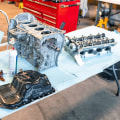Ignition and electrical systems are critical components of any car. Without them, the engine wouldn't start, and the car wouldn't move. But what are the different types of ignition and electrical specs? What do they mean, and how can they affect your car? This article will provide an overview of the various ignition and electrical specs and types, and how they relate to the Triumph TR line of vehicles. We'll take a look at the various electrical specs and types, including spark plugs, wires, coils, distributors, alternators, starters, and more. We'll also explain how these components are related to the Triumph TR powertrain, and what the effects of modifications might be.
Finally, we'll consider some of the safety considerations when working with these components.
Ignition and Electrical Specs and Types
– The Triumph TR is a classic car that has a variety of ignition and electrical systems. In order to keep these systems running smoothly, it's important to understand the different components and how to service them. The ignition system in the Triumph TR includes an ignition switch, starter motor, alternator, and other parts. The ignition switch is responsible for turning the engine on and off, while the starter motor is responsible for turning the engine over.The alternator provides electricity to the vehicle when the engine is running. Other components in the system include spark plugs, distributor, and ignition coils. All of these components work together to start and run the engine. Servicing these components is important in order to maintain their functionality and reliability.
Replacing worn-out or corroded parts, such as ignition switches or starters, can prevent electrical issues from occurring. Additionally, it's important to make sure that all connections are properly secured in order to avoid any shorts or other problems. When servicing electrical components, it's important to keep safety in mind. Always use insulated tools and wear protective gear when working with electrical components.
Additionally, be sure to disconnect the battery before starting any work on the electrical system. The Triumph TR comes with a variety of different ignition and electrical systems depending on the model year or trim level. For example, some models may come with an electronic ignition system that uses sensors and a computer to control the timing of spark plugs. Other models may come with a more traditional mechanical ignition system that uses a distributor and points to control the timing of spark plugs.
Each type of system has its own advantages and disadvantages. Electronic systems are more reliable than mechanical systems but may be more expensive to replace due to their complexity. Mechanical systems are often simpler and less expensive to repair but can be prone to more wear-and-tear over time. No matter what type of system your Triumph TR has, it's important to understand how it works and how to service it.
By familiarizing yourself with the different components and understanding how they work together, you can keep your vehicle running smoothly for years to come.
Ignition Switches
Ignition Switches are essential components of a vehicle's electrical system. They are responsible for starting the vehicle by supplying the necessary current to the starter motor and other ignition components. Ignition switches also provide power to other components such as the headlights and radio. An ignition switch consists of a series of contacts and a spring-loaded movable contact.When the key is inserted into the switch, it rotates the movable contact and connects the contacts to provide power to the starter motor and other ignition components. Servicing an ignition switch on a Triumph TR is a relatively simple process. First, you should inspect the switch for any signs of damage or corrosion. If any damage is found, the switch should be replaced.
Otherwise, you can use a small screwdriver to adjust the contacts until they are properly aligned. When replacing an ignition switch on a Triumph TR, it's important to make sure that you use a compatible model. The correct part number should be referenced in your owner's manual or a manual from a Triumph TR specialist. Once you have installed the new ignition switch, you should test it by starting the engine and checking that all electrical components are functioning properly.
Starter Motors
A starter motor is an electric motor that helps to start an internal combustion engine.It is typically used in cars and other vehicles and is responsible for turning the crankshaft to start the engine. The starter motor works by receiving a signal from the ignition switch and sending an electrical current to the starter solenoid, which then activates the starter gear. The starter gear engages with the flywheel or flexplate of the engine, allowing the engine to turn over and start. The starter motor is an essential component of any car and is a vital part of keeping your Triumph TR running properly. To keep it running smoothly, it is important to regularly service your starter motor.
This includes checking the battery connections, cleaning the contacts, and inspecting the brushes for wear. If necessary, a replacement starter motor may be needed.
How to Service a Starter Motor on a Triumph TR
Servicing a starter motor on a Triumph TR is not complicated, but it does require some basic knowledge of car mechanics. First, check the battery connections to make sure they are secure and free of corrosion. Then, clean the contacts to make sure they are free of dirt and grime.Finally, inspect the brushes for any signs of wear or damage. If they are worn down or damaged, they will need to be replaced. If your starter motor needs replacing, you will need to buy a new one that is designed specifically for your Triumph TR model. Make sure to follow the manufacturer's instructions for installation. Once installed, test your starter motor to make sure it is working properly before taking your car back on the road.
Alternators
Alternators are an essential component of the electrical system in a car, responsible for generating power to keep the battery charged and other components running.In the Triumph TR, alternators are typically mounted near the engine and connected to the crankshaft with a belt. Alternators are powered by electricity created by the movement of the crankshaft, which is then converted into alternating current (AC). This AC is then used to charge the car's battery and power other electrical components. The alternator in a Triumph TR should be serviced on a regular basis in order to keep it functioning properly.
This may include replacing or cleaning the belt and checking the alternator's output voltage. If the alternator is not working properly, it could cause problems with the car's electrical system, including a dead battery or flickering lights. If the alternator needs to be replaced, it is important to use one that is compatible with the Triumph TR's electrical system. In order to service or replace an alternator on a Triumph TR, you will need to remove the old alternator from its mounting position. Next, you will need to install the new alternator and connect it to the crankshaft with a new belt. This may include replacing or cleaning the belt and checking the alternator's output voltage. If the alternator is not working properly, it could cause problems with the car's electrical system, including a dead battery or flickering lights. If the alternator needs to be replaced, it is important to use one that is compatible with the Triumph TR's electrical system. In order to service or replace an alternator on a Triumph TR, you will need to remove the old alternator from its mounting position. Next, you will need to install the new alternator and connect it to the crankshaft with a new belt.
After installation is complete, you should check all of the connections and test the output voltage of the alternator before putting everything back together. This article has discussed the importance of understanding and servicing the ignition and electrical components in the Triumph TR. It has gone into detail about ignition switches, starter motors, alternators, and other components, as well as the best practices for maintaining these parts. It is important to regularly check and service these components to ensure that the car runs as smoothly and efficiently as possible.
Additionally, if any of these components need to be replaced, it is important to ensure that they are correctly installed. With proper maintenance, the Triumph TR can continue to be a classic and reliable vehicle.


